 英浓度分布及其健康风险评估
英浓度分布及其健康风险评估  英(PCDD/Fs)浓度水平进行监测并对其组成特征进行了分析,运用主成分分析法(PCA)对周边环境空气中二
英(PCDD/Fs)浓度水平进行监测并对其组成特征进行了分析,运用主成分分析法(PCA)对周边环境空气中二 英来源进行了初步解析,同时采用VLIER-HUMAAN模型评估其对人体的健康风险.结果表明该医疗废物焚烧厂烟气二
英来源进行了初步解析,同时采用VLIER-HUMAAN模型评估其对人体的健康风险.结果表明该医疗废物焚烧厂烟气二 英毒性当量浓度为0.542~21.300 ng·Nm-3(以I-TEQ计),排放水平较高;周边环境空气中PCDD/Fs质量浓度和毒性当量浓度变化范围分别为0.682~196.000 pg·m-3和0.036~17.700 pg·m-3(以I-TEQ计),周边环境空气中PCDD/Fs浓度明显受到排放源烟气落地点的影响.空气样品中二
英毒性当量浓度为0.542~21.300 ng·Nm-3(以I-TEQ计),排放水平较高;周边环境空气中PCDD/Fs质量浓度和毒性当量浓度变化范围分别为0.682~196.000 pg·m-3和0.036~17.700 pg·m-3(以I-TEQ计),周边环境空气中PCDD/Fs浓度明显受到排放源烟气落地点的影响.空气样品中二 英同族体及异构体分布指纹谱图与该焚烧设施排放烟气类似,空气质量浓度主要贡献单体以OCDD、1,2,3,4,6,7,8-HpCDF、OCDF以及1,2,3,4,6,7,8-HpCDD为主,主要毒性贡献单体为2,3,4,7,8-PeCDF.PCA源解析结论与指纹谱图特征分析结论基本一致,该研究区域中环境空气二
英同族体及异构体分布指纹谱图与该焚烧设施排放烟气类似,空气质量浓度主要贡献单体以OCDD、1,2,3,4,6,7,8-HpCDF、OCDF以及1,2,3,4,6,7,8-HpCDD为主,主要毒性贡献单体为2,3,4,7,8-PeCDF.PCA源解析结论与指纹谱图特征分析结论基本一致,该研究区域中环境空气二 英主要来源于医疗废物焚烧烟气排放.健康风险评估结果表明,该区域人群呼吸暴露风险总体处于较为安全的水平(0.0032~0.141 pg TEQ·kg-1·d-1),部分个体的呼吸暴露贡献率超过了评价限值,应引起重视.
英主要来源于医疗废物焚烧烟气排放.健康风险评估结果表明,该区域人群呼吸暴露风险总体处于较为安全的水平(0.0032~0.141 pg TEQ·kg-1·d-1),部分个体的呼吸暴露贡献率超过了评价限值,应引起重视. 英 主成分分析 健康风险评估
英 主成分分析 健康风险评估 医疗废物是指医疗卫生机构在医疗、预防、保健及其他相关活动中产生的具有直接或者间接感染性、毒性及其他危害性的废物(Hossain et al., 2011), 其在《国家危险废物名录》中被列为“头号危险废物”(环境保护部, 2016).随着我国医疗卫生事业的不断发展, 医疗废物的产生量每年都在剧增, 医疗废物的处置能力也不断提高.《2018年全国大、中城市固体废物污染环境防治年报》显示:2017年全国202个大、中城市医疗废物产生量78.1×104 t, 处置量77.9×104 t, 大部分城市的医疗废物处置率都达到了100%.目前我国医疗废物的处置技术主要有回转窑焚烧法、热解法、高温蒸汽灭菌法、化学消毒法和微波消毒法等(Jiang et al., 2012; Chen et al., 2013), 其中焚烧处置因具有快速减容、减量、减毒的能力, 成为当前处置医疗废物主要采用的方法(Jang et al., 2006), 但焚烧过程会产生大量的二
二















研究区域为广东省某一典型医疗废物焚烧厂, 地处山坳, 采样点附近无其它明显的二

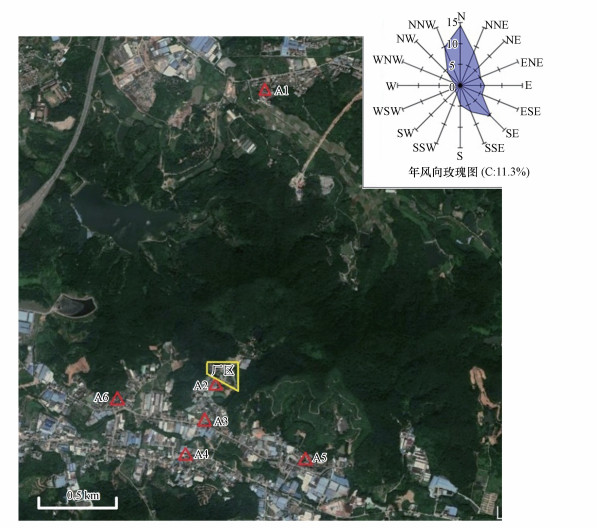 |
| 图 1 环境空气采样点分布示意图 Fig. 1 Ambient air sampling sites around the MWI |
烟气采样方法参照HJ77.2—2008, 采样仪器为烟气采样器(MEGA, APIS, 意大利), 采样前在树脂筒内加入37Cl或13C标记的采样内标EPA 23 SSS, 每个样品采集2 h, 采样量约为2.5 Nm3, 连续采集3个样品.
2.2.2 环境空气样品采集根据有关季节性PCDD/Fs含量的研究, 冬季空气中PCDD/Fs含量最高(Die et al., 2015), 同时考虑到该研究区域常年无固定风向, 冬季以东北或北风为主, 此时研究区域下风向居民聚居密集, 因此分别在2015—2018年的冬季(12月—2月)进行了4次样品采集.采样方法参考HJ77.2—2008, 采样仪器为大流量环境空气采样器(MEGA, HORNET, 意大利), 分别用石英纤维滤膜(Whatman, 20.3 cm×25.4 cm)和聚氨酯泡沫(PUF, 90 mm×50 mm)收集颗粒相和气相二
甲苯、正己烷为高效液相色谱级溶剂(美国Honeywell公司), 二氯甲烷为高效液相色谱级溶剂(德国Merck公司), 弗罗里硅土(美国Fluka公司), 硅胶(德国Merck公司), 碱性氧化铝(美国Sigma公司), 无水硫酸钠、浓硫酸(广州化学试剂公司), 采样内标、提取内标及进样内标(美国Wellington公司).
2.3.2 样品前处理和净化环境空气样品用甲苯对石英纤维滤膜和PUF连续抽提24 h, 烟气样品滤筒和树脂用甲苯连续抽提24 h, 冷凝水用二氯甲烷萃取3次后与抽提液合并, 空气样品抽提液、烟气样品的抽提液和萃取液的合并液浓缩后经多段层析柱净化, 层析柱填料从上至下为:2 g无水硫酸钠、40 g酸性硅胶、3 g中性硅胶、4 g碱性硅胶、3 g中性硅胶、3 g中性氧化铝、1 g弗罗里硅藻土、2 g无水硫酸钠.开始净化前用80 mL正己烷预淋洗层析柱, 上样后依次用120 mL正己烷、30 mL正己烷:二氯甲烷混合液(95:5, 体积比)洗脱去除干扰物, 再用100 mL二氯甲烷继续洗脱, 将洗脱液旋转蒸发至2 mL, 最后用高纯氮吹扫浓缩至30 μL后加入13C标记的进样内标, 待仪器分析.
2.3.3 仪器分析采用高分辨气相色谱/高分辨双聚焦磁式质谱联用仪(Agilent 7890N GC/ Waters Autospec Premier, P848)分析, 载气流速为1.0 mL·min-1, 色谱柱为DB-5 (60 m×0.25 mm×0.25 μm), 进样量为1 μL, 不分流进样.色谱柱升温程序:初始温度为90 ℃, 保持2 min, 然后以18 ℃·min-1的速率升至220 ℃, 再以1.4 ℃·min-1升至260 ℃, 最后4 ℃·min-1升至310 ℃, 保持4 min, 进样口温度为280 ℃.质谱条件:电离能:35 eV;离子化电流:650 μA;EI源温度:280 ℃;分辨率≥10000.
2.3.4 质量保证与质量控制采用13C同位素内标稀释定量法对环境空气和烟气样品中二
目前关于环境多介质中PCDD/Fs的人体健康风险评估的报道较少, 这些污染物可通过呼吸、皮肤暴露和食物摄取等途径进入到人体内, 其中经呼吸途径是大气二



|
(1) |
式中:IPad/ch指经呼吸二


本研究中医疗废物焚烧厂2015—2018年排放烟气中PCDD/Fs的I-TEQ含量如图 2所示, 烟气中PCDD/Fs的实测质量浓度变化范围为2.41~1219 ng·m-3, 毒性当量浓度为0.542~21.3 ng·Nm-3(以I-TEQ计).监测结果显示, 2015—2018年, 医疗废物焚烧厂焚烧炉PCDD/Fs排放量均高于我国危险废物焚烧控制标准限值0.5 ng·Nm-3(以I-TEQ计).与Gao等(2009)对全国各地14个医疗废物焚烧炉的监测结果相当, 高于陈佳等(2014)统计的全国41处医疗废物焚烧设施二
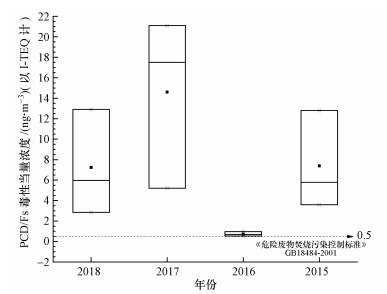 |
| 图 2 医疗废物焚烧厂烟气中PCDD/Fs毒性当量浓度 Fig. 2 PCDD/Fs emission level in flue gas of the MWI |

6个采样点4次监测得到的环境空气中PCDD/Fs浓度如表 1所示, 其中PCDD/Fs总质量浓度范围为0.682~196 pg·m-3, PCDD/Fs毒性当量浓度范围为0.036~17.7 pg·m-3(以I-TEQ计).从表 1可以看出, 除了2015年冬季A2采样点外, 其余各时期采样点位PCDD/Fs毒性当量浓度均低于黄文等(2013)对西北某医疗废物焚烧厂周边环境空气中PCDD/Fs浓度的调查结果(0.062~26.0 pg·m-3(以I-TEQ计)), 低于苏原等(2014)对广州环境空气中二

| 表 1 各采样点环境空气中PCDD/Fs总质量浓度及毒性当量浓度 Table 1 Mass and TEQ concentrations of PCDD/Fs in the samples at each sampling site |
从分布情况来看, 本研究中主导下风向各采样点环境空气中PCDD/Fs浓度明显高于上风向, 近源采样点在各采样时期PCDD/Fs浓度水平均较高, 并随着与排放源的距离增加出现先增高后降低的趋势, 表明厂界区域可能受到此焚烧设施的影响相对高于其他采样点, 并且当焚烧设施排放烟气中PCDD/Fs浓度高时, 周边环境空气中PCDD/Fs的浓度也相应较高, 说明周边环境空气中PCDD/Fs浓度明显受到排放源烟气落地点的影响.此外, 2015年A2采样点监测结果显示PCDD/Fs浓度明显高于其他年份同期水平, 分析其原因除了跟该采样点离焚烧设施距离较近、采样期间该焚烧设施排放烟气中PCDD/Fs浓度较高有关外, 还可能与该采样点采样期间气象条件为静风不利于二
本研究用各同类物占总质量浓度的百分比指示其分布特征, 烟气和环境空气中PCDD/Fs同类物质量浓度百分比分布如图 3和图 4所示.由图 3可以看出, 烟气中PCDFs的浓度高于PCDDs的浓度, 总体上烟气中PCDD/Fs以1, 2, 3, 4, 6, 7, 8-HpCDF、OCDF、OCDD和1, 2, 3, 4, 6, 7, 8-HpCDD为主, 与Wang等(2014)对医疗废物焚烧烟气中PCDD/Fs调查结果一致, 与研究报道(Karademir et al., 2004; Ferré-Huguet et al., 2006; Kao et al., 2006)的危险废物焚烧二






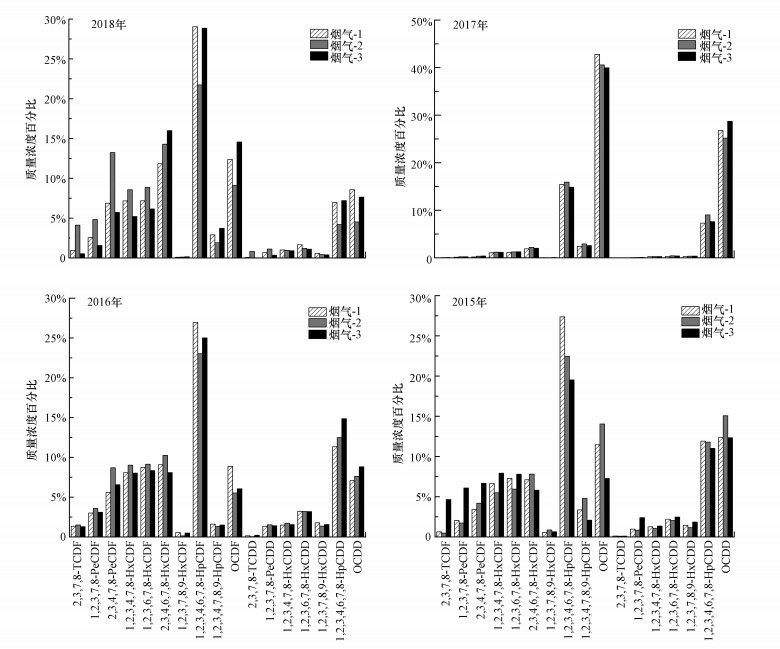 |
| 图 3 烟气中PCDD/Fs同类物质量浓度分布比例 Fig. 3 Content distribution of PCDD/Fs congeners in flue gas |
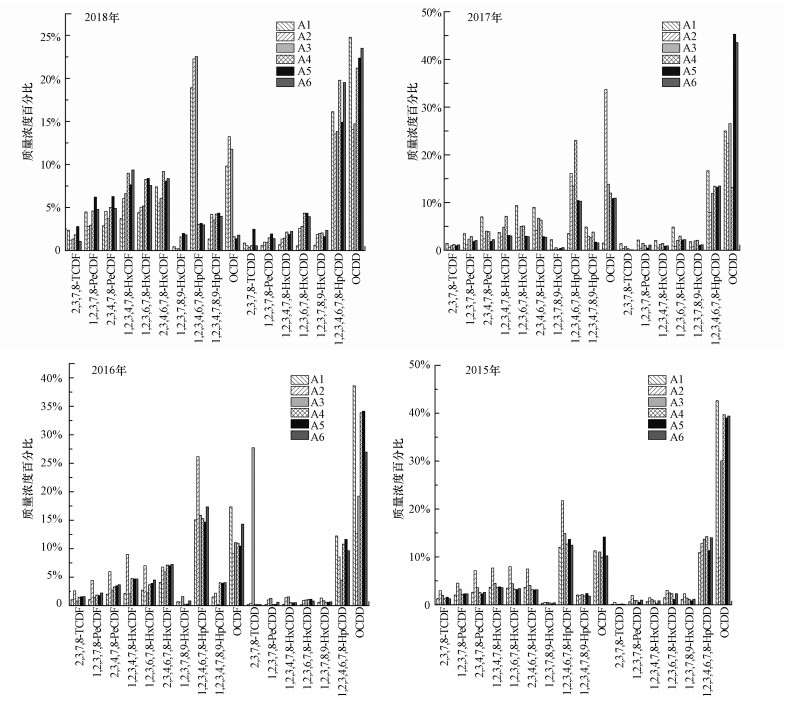 |
| 图 4 环境空气中PCDD/Fs同类物质量浓度分布比例 Fig. 4 Content distribution of PCDD/Fs congeners in ambient air |
如图 5所示, 各采样点空气样品中二
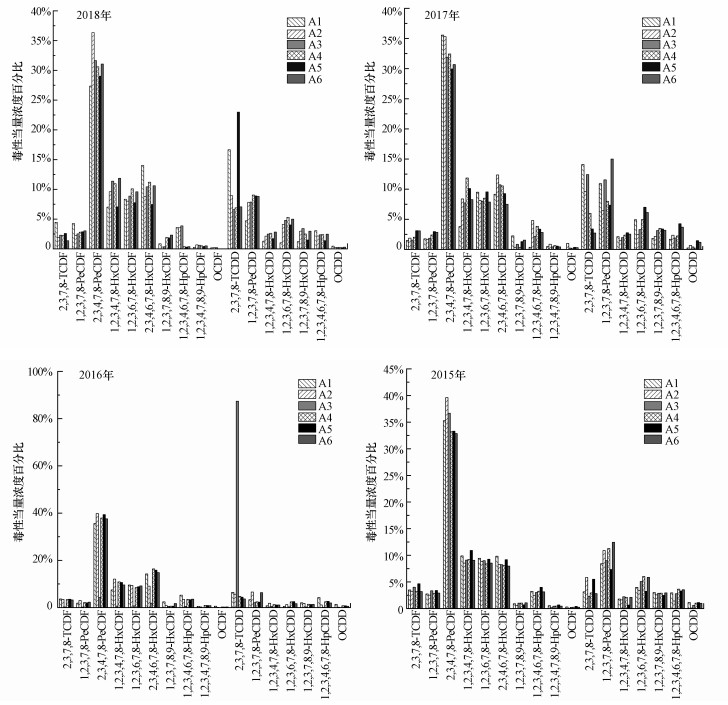 |
| 图 5 环境空气中PCDD/Fs同类物毒性当量浓度分布比例 Fig. 5 Content distribution of PCDD/Fs congeners (I-TEQ) in ambient air |
对比分析该医疗废物焚烧厂排放源烟气中PCDD/Fs(图 6)与环境空气中PCDD/Fs的毒性异构体分布特征显示, 各个采样点环境空气中起主要贡献的单体与烟气有较为相似的分布特征, 具体表现为:环境空气和烟气样品中PCDFs的主要毒性贡献单体均为2, 3, 4, 7, 8-PeCDF和2, 3, 4, 6, 7, 8-HxCDF, PCDDs的主要毒性贡献单体为1, 2, 3, 7, 8-PeDD, 表明该医疗废物焚烧厂烟气排放对这些点位的影响较为显著.
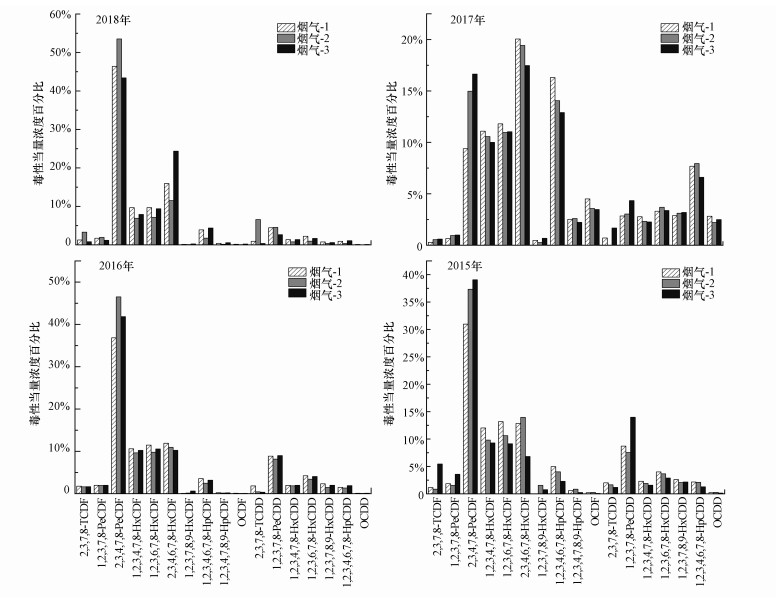 |
| 图 6 烟气中PCDD/Fs同类物毒性当量浓度分布比例 Fig. 6 Content distribution of PCDD/Fs congeners (I-TEQ) in flue gas |
运用主成分分析法(PCA)对排放源烟气和空气样品之间PCDD/Fs的17种2, 3, 7, 8-位取代二

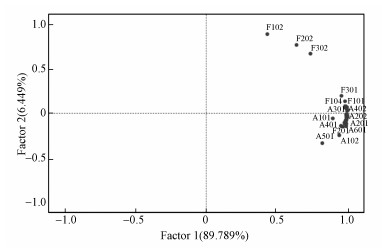 |
| 图 7 烟气与环境空气中PCDD/Fs主成分分析 Fig. 7 PCA analysis of PCDD/Fs in flue gas and ambient air |
二

| 表 2 医疗废物焚烧厂周边环境空气中PCDD/Fs对人体的呼吸日暴露量 Table 2 Daily exposure dose of PCDD/Fs by respiration in ambient air around MWI |
本研究的健康风险评价还存在一定程度的不确定性, 主要源于人群体质、工作性质、暴露时间长短和二
1) 本研究中医疗废物焚烧厂烟气二
2) 焚烧设施周边环境空气质量浓度主要贡献单体以OCDD、1, 2, 3, 4, 6, 7, 8-HpCDF、OCDF以及1, 2, 3, 4, 6, 7, 8-HpCDD为主, 主要毒性贡献单体为2, 3, 4, 7, 8-PeCDF, 与排放源烟气中PCDD/Fs同系物分布特征相似.环境空气中PCDFs的浓度高于PCDDs的浓度, 具有热源影响的特征.
3) 样品中PCDD/Fs分布特征和主成分分析表明, 该研究区域中环境空气二
4) 对医疗废物焚烧厂周边区域人群的PCDD/Fs呼吸暴露剂量的估算结果表明研究区域人群呼吸暴露风险总体处于较为安全的水平, 部分个体的呼吸暴露贡献率超过了评价限值, 应引起重视.
Chen Y, Ding Q, Yang X L, et al. 2013. Application countermeasures of non-incineration technologies for medical waste treatment in China[J]. Waste Management & Research, 31(12): 1237-1244. |
陈佳, 陈彤, 王奇, 等. 2014. 中国危险废物和医疗废物焚烧处置行业二  英排放水平研究[J]. 环境科学学报, 34(4): 973-979. 英排放水平研究[J]. 环境科学学报, 34(4): 973-979. |
邓芸芸.2007.广州市机动车来源多环芳烃与二 |
杜国勇, 苏原, 任明忠, 等. 2014. 气象因素对广州市大气中二  英污染特征的影响[J]. 环境科学, 35(8): 2857-2683. 英污染特征的影响[J]. 环境科学, 35(8): 2857-2683. |
Die Q Q, Nie Z Q, Liu F, et al. 2015. Seasonal variations in atmospheric concentrations and gas-particle partitioning of PCDD/Fs and dioxin-like PCBs around industrial sites in Shanghai, China[J]. Atmospheric Environment, 119: 220-227. DOI:10.1016/j.atmosenv.2015.08.022 |
Fabrellas B, Sanz P, Abad E, et al. 2001. The Spanish dioxin inventory part Ⅰ:Incineration as municipal waste management system[J]. Chemosphere, 43(4): 683-688. |
Ferré-Huguet N, Nadal M, Schuhmacher M, et al. 2006. Environmental impact and human health risks of polychlorinated dibenzo-p-dioxins and dibenzofurans in the vicinity of a new hazardous waste incinerator:a case study[J]. Environmental Science and Technology, 40(1): 61-66. DOI:10.1021/es051630+ |
Gao H, Ni Y, Zhang H, et al. 2009. Stack gas emissions of PCDD/Fs from hospital waste incinerators in China[J]. Chemosphere, 77(5): 643-639. |
Gao L R, Zhang Q, Liu L D, et al. 2014. Spatial and seasonal distributions of polychlorinated dibenzo-p-dioxins and dibenzifurans polychlorinated biphenyls around a municipal solid waste incinerator, determined using polyurethane foam passive air samplers[J]. Chemosphere, 114: 317-326. DOI:10.1016/j.chemosphere.2014.04.100 |
国家环境分析测试中心. 2009. HJ 77.2-2008.环境空气和废气二 |
Hossain M S, Santhanam A, Nik Norulaini N A, et al. 2011. Clinical solid waste management practices and its impact on human health and environment-a review[J]. Waste Management, 31(4): 754-766. DOI:10.1016/j.wasman.2010.11.008 |
Hoyos A, Cobo M, Aristizabal B, et al. 2008. Total suspended particulate (TSP), polychlorinated dibenzodioxin (PCDD) and polychlorinated dibenzofuran (PCDF) emissions from medical waste incinerators in Antioquia[J]. Colombia Chemosphere, 73: S137-S142. DOI:10.1016/j.chemosphere.2007.03.079 |
胡习邦, 许振成, 王俊能, 等. 2011. 环境介质中PCDD/Fs人群健康风险评价-以珠江三角洲为例[J]. 生态环境学报, 20(2): 311-316. DOI:10.3969/j.issn.1674-5906.2011.02.018 |
环境保护部.2008.关于进一步加强生物质发电项目环境影响评价管理工作的通知[OL].http://www.mee.gov.cn/gkml/hbb/bwj/200910/t20091022_174611.htm,2008-09-04
|
环境保护部. 2016.国家危险废物名录.[OL]. 2016-06-14. http://www.zhb.gov.cn/gkml/bl/201606/t20160621_354852.htm
|
黄文, 张素坤, 杜国勇, 等. 2013. 医疗废物焚烧炉周边环境介质中二  英的浓度、同系物分布于来源分析[J]. 环境科学, 34(8): 3238-3243. 英的浓度、同系物分布于来源分析[J]. 环境科学, 34(8): 3238-3243. |
Jang Y C, Lee C, Yoon O S, et al. 2016. Medical waste management in Korea[J]. Journal of Environmental Management, 80(2): 107-115. |
Jiang C, Ren Z Y, Tian Y J, et al. 2012. Application of best available technologies on medical wastes disposal/treatment in China(with case study)[J]. Procedia Environmental Sciences, 16: 257-265. DOI:10.1016/j.proenv.2012.10.036 |
Kao J H, Chen K S, Chang-Chien G P, et al. 2006. Emissions of polychlorinated dibenzo-p-dioxins and dibenzofurans from various stationary sources[J]. Aerosol air Quality Research, 6: 170-179. DOI:10.4209/aaqr.2006.06.0005 |
Karademir A. 2004. Health risk assessment of PCDD/Fs emissions from a hazardous and medical waste incinerator in Turkey[J]. Environment International, 30: 1027-1038. DOI:10.1016/j.envint.2004.05.008 |
刘劲松, 许行义, 高亮, 等.2006.我国部分医疗垃圾焚烧炉二 |
Lee W S, Chang-Chien G P, Wang L C, et al. 2003. Emission of polychlorinated dibenzo-p-dioxins and dibenzofurans from the incinerations of both medical and municipal solid wastes[J]. Aerosol Air Quality Research, 3(1): 1-6. DOI:10.4209/aaqr.2003.06.0001 |
Li H R, Feng J L, Sheng G Y, et al. 2008. The PCDD/Fs and PBDD/Fs pollution in the ambient atmosphere of Shanghai, China[J]. Chemosphere, 70: 576-583. DOI:10.1016/j.chemosphere.2007.07.001 |
Listed N. 1997. Polychlorinated dibenzo-para-dioxins[J]. Iarc Monographs on the Evaluation of Carcinogenic Risks to Humans, 69(1): 307-316. |
Liu H M, Lu Y S, Buekens A G, et al. 2012. Baseline soil levels of PCDD/Fs established prior to the construction of municipal solid waste incinerators in China[J]. Chemosphere, 86(3): 300-307. DOI:10.1016/j.chemosphere.2011.10.033 |
Lohmann R, Northcott G, Jones K C. 2000. Assessing the contribution of diffuse domestic burning as a source of PCDD/Fs, PCBs, and PAHs to the U.K. atmosphere[J]. Environmental Science and Technology, 34(14): 2892-2899. DOI:10.1021/es991183w |
Maguhn J, Karg E, Kettrup A, et al. 2003. On-line analysis of the size distribution of fine and ultrafine aerosol particles in flue and stack gas of a municipal waste incineration plant:effects of dynamic process control measures and emission reduction devices[J]. Environmental Science & Technology, 37(20): 4761-4770. |
穆乃花, 张素坤, 任明忠, 等. 2014. 垃圾焚烧厂周边空气二  英含量水平与暴露风险评估[J]. 环境影响评价, 2: 51-55. DOI:10.3969/j.issn.1674-2842.2014.05.018 英含量水平与暴露风险评估[J]. 环境影响评价, 2: 51-55. DOI:10.3969/j.issn.1674-2842.2014.05.018 |
Mi H H, Wang W J, Lin S L, et al. 2014. Long-term monitoring and modeling of polychlorinated dibenzo-p-dioxins and dibenzofurans from municipal solid waste incinerators and surrounding area in northern Taiwan[J]. Environmental Science and Pollution Research, 21(18): 10751-10764. DOI:10.1007/s11356-014-3019-0 |
Ni Y W, Zhang H J, Fan S, et al. 2009. Emission of PCDD/Fs from municipal solid waste incinerators in China[J]. Chemosphere, 75: 1153-1158. DOI:10.1016/j.chemosphere.2009.02.051 |
Nouwen J, Cornelis C, Fré R D, et al. 2001. Health risk assessment of dioxin emissions from municipal waste incinerators:the Neerlandquarter(Wilrijk, Belgiun)[J]. Chemosphere, 43(4/7): 909-923. |
Oh J E, Choi S D, Lee S J, et al. 2006. Influence of a municipal solid waste incinerator on ambient air and soil PCDD/Fs levels[J]. Chemosphere, 64(4): 579-587. DOI:10.1016/j.chemosphere.2005.11.012 |
彭金玲, 张建清, 陆少游, 等. 2015. 深圳市大气细颗粒物中二  英污染水平及人群暴露风险分析[J]. 卫生研究, 44(4): 570-575. 英污染水平及人群暴露风险分析[J]. 卫生研究, 44(4): 570-575. |
Schecter A, Birnbaum L, Ryan J J, et al. 2006. Dioxins:an overview[J]. Environmental Research, 101(3): 419-428. DOI:10.1016/j.envres.2005.12.003 |
苏原, 张素坤, 任明忠, 等. 2014. 广州大气二  英污染水平及其季节变化特征[J]. 环境科学研究, 27(8): 813-819. 英污染水平及其季节变化特征[J]. 环境科学研究, 27(8): 813-819. |
孙杰, 李华娟, 周苗苗, 等. 2017. 垃圾焚烧厂周围环境空气中二  英浓度分布及其健康风险评估[J]. 环境污染与防治, 39(3): 280-285. 英浓度分布及其健康风险评估[J]. 环境污染与防治, 39(3): 280-285. |
Tian H H, Ouyang Ne. 2003. Prelinary investigation on dioxins emission from MSW incinerators[J]. Environmental Chemistry, 22: 255-258. |
US EPA.2001.Database of sources of environmental releases of dioxin-like compounds in the United States[R]. EPA/600/C-01/012. Washington, DC: US EPA
|
Van Hall Instituut. 1997. VLIER-HUMAAN, version 1997[M]. Leeuwarden: Van Hall instituut.
|
Vassura I, Passarini F, Bernardi F, et al. 2011. PCDD/Fs atmospheric deposition fluxes and soil contamination close to a municipal solid waste incinerator[J]. Chemosphere, 83(10): 1366-1373. DOI:10.1016/j.chemosphere.2011.02.072 |
Wagrowski D M, Hites R A. 2000. Insights into the global distribution of polychlorinated dibenzo-p-dioxins and dibenzofurans[J]. Environment Science & Technology, 34(14): 2952-2959. |
Wang Q, Jin Y Q, Li X D, et al. 2014. PCDD/Fs Emissions from hazardous waste incinerators in China[J]. Aerosol and Air Quality Research, 14: 1152-1159. DOI:10.4209/aaqr.2013.03.0069 |
Wevers M, Fré R D, Desmedt M. 2004. Effect of backyard burning on dioxin deposition and air concentrations[J]. Chemosphere, 54(9): 1351-1356. DOI:10.1016/S0045-6535(03)00253-4 |
Yu L P, Mai B X, Meng X J, et al. 2006. Particle-bound polychlorinated dibenzo-p-dioxins and dibenzofurans in the ambient air of Guangzhou, China[J]. Atmospheric Environment, 40: 96-108. DOI:10.1016/j.atmosenv.2005.09.038 |
Zhang M W, Zhang S K, Zhang Z Q, et al. 2014. Influence of a municipal solid waste incinerator on ambient air PCDD/F levels:a comparison of running and non-running periods[J]. Science of the Total Environment, 491-492: 34-41. DOI:10.1016/j.scitotenv.2014.03.100 |
Zhou Z G, Zhao B, Qi L, et al. 2008. Distribution of polychlorinated-p-dioxins and dibenzofurans in the atmosphere of Beijing, China[J]. Atmosphere Environment, 42: 2037-2047. DOI:10.1016/j.atmosenv.2007.12.005 |
王奇. 2014.危险废物焚烧厂二 |
严密. 2012.医疗废物焚烧过程二 |
 2019, Vol. 39
2019, Vol. 39


